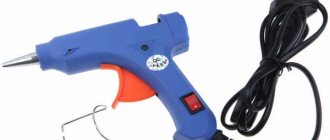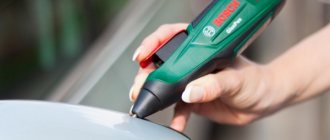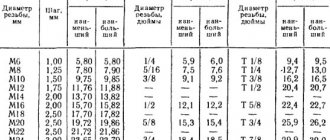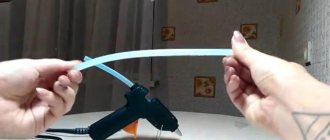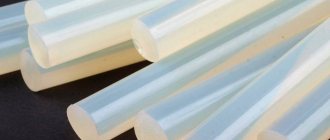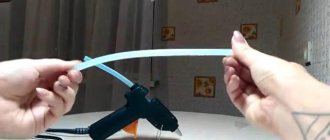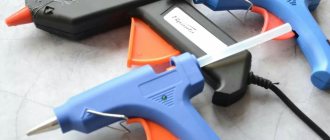Most hot melt guns that use hot melts for gluing are very similar to each other, both in the operating principle and in the general design of the design. The only differences are the quality of materials and workmanship, service life and ergonomics. This coincidence can be explained simply; the main secret of high-quality gluing lies in what kind of glue gun refills are used in the work. Manufacturers of branded pistol brands always equip their models with branded adhesive materials. This is not charity or advertising. This is done so that the user gets an idea of how the machine works using high-quality hot-melt glue, what consumables to look for, and how to choose a glue stick for a glue gun.
What is a glue stick
Consumables for a glue gun are flexible polymer rods up to 20 cm long and 7 mm or 11 mm in diameter. Thinner rods are usually used for soldering with low-power home soldering guns. Hot-melt glue rods with a diameter of 11-12 mm are used for more powerful and productive guns, most often professional and semi-professional types.
The material is elastic and at the same time durable, it is very difficult to tear the glue stick with your hands, you can slightly bend it, and some brands can even be rolled into a donut.
Anyone who regularly uses a hot glue gun at home or in professional activities notes some features of the consumable:
- The adhesive cartridge placed in the gun holder does not melt and does not lose its properties, even if the gun sits in standby mode for half a day. At the end of the work, the thermal rod remains in the holder and does not need to be removed or replaced. If you need to glue, the gun is simply plugged in, and after five minutes the device is ready for use;
- There is no surface wear, hot melt material does not cause erosion, oxidation or burning of the melting chamber. The gun will work until the heater burns out;
- The shelf life of consumables with proper storage is practically unlimited; the polymer is not afraid of freezing or short-term heating without melting. Some brands of glue sticks used for high-strength, rigid adhesives can absorb moisture. In this case, it is enough to dry the adhesive material in the sun, and it is ready for use;
- The relatively soft rod retains its qualities until it enters the melting chamber and turns into a melt. During the cooling process, structural transformations occur in the polymer; from an elastic and soft material that feels very much like a piece of hard silicone, the drop turns into a very hard and rigid “glass” bead.
The material of the rods is not thermosetting; when reheated, it can be melted, but due to the increase in viscosity, it is almost impossible to squeeze it through the nozzle of the melting chamber; a very large force will be required.
Problems and their solutions
The most common problem when working with a heat gun is that the glue flows uncontrollably, without pressing the trigger. There may be several reasons:
- The temperature is too high for a particular rod. It is optimal when the heat gun has a heating regulator to set the required melting degrees. Otherwise you will have to replace the rods. In a good gun, the nozzle has a ball valve - the so-called drip protection;
- The rod is inserted too tightly. Sometimes it helps to move it back a little;
- rod diameter mismatch. Some models require decimal sizes. For example, Sigma - 11.2 mm. If you put an 11 mm rod into such a device, a pressure difference occurs inside the heater, and the glue flows back. Using rods of the correct diameter solves the issue;
- low quality pistol. You can insert a toothpick into the nozzle during a pause in work. Or accept it and try to finish the work as quickly as possible: the contents flow out very quickly.
If the glue stops coming out, the gun may be clogged. It is disassembled and cleaned. To avoid this, do not allow glue to stick around the nozzle.
You can get excellent results and joy from work only with a working hot glue gun
For battery-powered models, the glue sometimes becomes viscous and has difficulty passing through the nozzle. You need to reheat the device in the charging station.
In cheap models, when there is a break in use for several minutes, the pusher gets stuck in the soft rod and cannot move it. You need to turn off the gun and let it cool.
If the glue stretches like a thread and you can’t apply a dot, craftswomen advise keeping the rods in the refrigerator. Most likely they are of low quality.
How to change the color of the rod correctly
To prime the gun, the rod is simply inserted into a special hole at the back. After finishing work, you don’t have to remove it. Then the next time you turn on the device will be immediately ready for use.
Sometimes it is necessary to change the color of the coming out glue, for example, blue to transparent
If the gun has cooled down, turn it on for about 1 minute, then carefully unscrew the rod. Charge the new one, press the trigger to squeeze out the remnants of the old one until the desired color appears
The new rod, after insertion, by smoothly pressing the trigger, completely pushes out the remnants of the old one
Why do you need to divide hot melt adhesive by diameter?
This also determines the choice of the diameter of the glue gun rods by the developers. The smaller the diameter, the less effort is required to squeeze the melt out of the melting chamber. To work with the refills for a 7 mm glue gun, very little effort is required, which means that the gun can be used by almost any adult or even a child.
Seven-millimeter rods are used in low-power and non-hot hot glue guns with small dimensions and weight. The melting point of such material rarely exceeds 160 o C, so the gluing device is very light and economical. They are convenient for gluing paper, film, packaging goods, and temporarily fixing parts on the desktop. If you need to glue tiles on the ceiling, it is much more convenient to do this with a glue gun with a seven-millimeter “cartridge”.
It seems convenient, but the productivity is only 10-15 g/min, which is enough for spot gluing, but not enough for full gluing. Therefore, for gluing metal, glass, wood, and plastic, 11 mm glue gun rods are used. In addition to the increased productivity to 25-30 g/min, the control temperature increases from 160 o C to 195 o C. The glue gun turns out to be twice as large and heavier, but it can glue almost anything that can withstand high temperatures.
Some glue gun manufacturers deliberately produce very inexpensive models with reduced tube diameters, for example, 7 mm and 11 mm, encouraging buyers to purchase only branded sticks. Therefore, before making a purchase, you should clarify three parameters:
- Melting temperature of the glue stick and compare it according to the passport with the characteristics of the gun;
- For what materials is the selected brand of hot-melt adhesive rod intended?
- The exact diameter of the rod, otherwise it may happen that your glue gun has a 7 mm clip, they offer to buy 11 mm.
You can even take with you an old package of thermal rods or look at the passport for the gun, which should contain all the necessary data on consumables. Otherwise, you will not be able to exchange or repair a burnt hot-melt glue gun under warranty.
What is a glue gun used for?
What is a glue gun used for and what does it glue? It's easier to say what he doesn't like. Using this small and convenient device, joints are sealed and installation seams are filled. It allows you to speed up the installation of ventilation in the garage and ensures quick installation of sound insulation. It makes it easy to glue up loose wallpaper or a curved baseboard on the ceiling or in a hard-to-reach corner. A stick-on gun will quickly and easily attach ceiling moldings or wall appliques.
Many types of force majeure repairs are carried out using softened and carefully dosed glue, including gluing up a decorative plaster stone that accidentally flew off - do not dilute a bucket of mortar just for the sake of one bounced tile. Designers and radio amateurs resort to the adhesive tool; it is useful for modeling and design. There are craftsmen who are able to add design advantages to the adhesive mass itself, placing it in balls, elongated beads or colorful rain on walls, panels, postcards and souvenirs. So the capabilities of such pistols are not limited to repairs.
Photo of glue gun, e-ukrservice.com
Pictured is a glue gun, e-ukrservice.com
Photo of a cordless glue gun, e-ukrservice.com
Photo - what can be glued with a glue gun, e-ukrservice.com
Photo - how to choose a glue gun, e-ukrservice.com
How to choose the right glue sticks for the job
Sometimes the situation is the opposite, for example, you have to look for a solution what to do if the rods are small and the glue gun is 11 mm. The situation is not the most critical, but high-quality glue sticks are quite expensive, and it would be unwise to refuse to use them. For example: one universal Boshev adhesive material for 11 mm costs 600-1000 rubles. per piece, but it’s enough for 4-5 sticks.
If the rods are smaller in diameter than the pistol clip, then the problem can be solved by slightly improving the trigger:
- The pistol body is disassembled and the swinging frame attached to the trigger is removed;
- The ring on the frame is wound with thin, 1-2 mm wire in PVC insulation;
- Reassemble the device body in the reverse order.
It is clear that any experiments with glue guns are an extreme case. There is a risk of damaging the most vulnerable component - the heating system; it will not be possible to repair the hot glue gun, and the expensive device will be scrapped.
What are glue sticks made of?
To make the principle of hot melt bonding more universal, manufacturers produce several main types of glue sticks:
- Ethylene vinyl acetate polymer has high fluidity and very high adhesion; it adheres well to any porous surface. The melting point is only 78-80 o C, so EVA is used only in low-temperature glue guns. The color of the ethylene vinyl acetate thermal rod is whitish, translucent;
- Polyamide plastic is characterized by an increased melting point of 150-155 o C, the adhesive melt is very viscous and viscous, but after the glue hardens, a seam is formed that is 40-50% stiffer and stronger than EVA. Most often, PAP is used in the industrial assembly of cladding and upholstery for automobiles and household appliances;
- Polyolefin material is the most refractory of all hot melt adhesives, the melt formation temperature is 180 o C. The seam is very hard, with low adhesion, so it is used mainly for spot gluing packaging;
- Modified silicone, the most plastic and fusible, melting point up to 100 o C, has high transparency, the frozen seam perfectly withstands tearing and shearing loads. A silicone stick for a glue gun is used for gluing fabrics, linoleum and in handicrafts.
High- and low-density polyethylenes also have very similar technological characteristics; often the cheapest adhesive sticks are made from granulated polyethylene. The quality of the seam is poor; when working on cheap machines, an oily smell may appear in the air.
Read also: Tightening wheel nuts with a torque wrench
Classification of glue sticks
In order to simplify the handling of hot-melt adhesive materials, a color classification of consumables has been adopted. That is, you can choose the appropriate version of the hot-melt base based on the manufacturer’s markings and the color of the rod. Often consumables are sold individually and without packaging, so the main reference point remains the color of the polymer.
White and yellow glue sticks
Milky white and opaque yellow hot-melt adhesive materials are produced on the basis of polyethylene and EVA, the main purpose is gluing paper, ceramics, wood, you can even glue ceiling tiles. Melt adhesion is lower than standard, but it is quite sufficient for fixing lightly loaded parts. The main advantages of the material are its low price and low melting point, so when working with a gluing machine, the risk of burning through the surface being glued is minimal.
Transparent white thermal rods are produced on the basis of ethylene vinyl acetate, which is considered a universal adhesive material that can be used to glue everything. Unlike previous rods, the transparent white seam turns out to be a little softer, with high adhesion, it can even stick to the skin of the hands and clothing, if the melt misses the target, after hardening it can be easily removed from the surface with a blade.
Crystal-transparent rods are usually produced on the basis of modified silicone. It can be used to glue wood, but is most often used to join fabrics, since at a low melting point the melt penetrates well into the surface and is practically invisible after hardening.
Transparent yellow adhesive thermal sticks are made from polyamide, which is very rigid, has low adhesion and can absorb moisture. Used as a universal hot melt adhesive for wood, plastic and metal.
Colored glue sticks
In addition to universal hot melt adhesives, specialized brands are available, for example, a black glue gun stick. Two types of hot-melt adhesive are produced under this color marking. The first is used exclusively as a high-strength and resistant waterproofing, for example, to seal seams at the joints of flanges and pipe fittings. The material is quite elastic, so loads do not lead to destruction of the cushioning layer.
The second option is glue sticks to enhance the insulation of contacts in electrical wiring systems. During the cooling process, hot melt adhesive provides very good adhesion to copper, brass or aluminum surfaces and at the same time slight shrinkage. The result is a virtually non-porous and durable coating.
Both versions of the black hot melt adhesive stick are made from EVA, so the hot melt adhesive is highly versatile and can be used for other purposes if necessary. Some Chinese manufacturers manage to produce black adhesive thermal rods, which, according to the labeling, are suitable for absolutely all materials, from metal to glass.
In addition, sets of 12 or 24 colors are made on the basis of EVA. In terms of their characteristics, colored rods are practically no different from universal ones, but they have one very valuable advantage. When gluing a colored surface, you can select a rod that matches the color and make the seam almost invisible.
Characteristics of hot-melt adhesive and features of use
First of all, I would like to talk about the device for which the glue sticks are actually intended. This is a glue gun that greatly simplifies the task of gluing surfaces. It is a device dependent on the electrical network, into which the same rods are inserted. The end of the rod enters the rubber receiver and then into the heating chamber. When you press the trigger, the glue comes out of the tip of the gun and is applied in an even layer to the surface.
After applying the mass, the surfaces to be glued must be fixed to each other until the adhesive has hardened.
Sometimes you can see the name “hot-melt glue”, which means the same thing as a glue stick. But not all stores and catalogs can find hot-melt adhesive, since it goes under a second name. Names such as “heat gun cartridges,” “hot glue,” or “sticker” are also used.
As mentioned earlier, a glue gun can glue almost any material in different combinations. If you start listing, the list can turn out to be endless; it includes plastic, tile, wood, metal, cardboard, fabric, paper and other materials. It would be better to indicate those materials that he is not able to glue. These are concrete, plaster, some types of fabrics and polyvinyl chloride.
If there are no additional requirements for the work, then gluing is carried out using guns with standard sizes. Typically, they use rods with a diameter of 7 and 11 mm, which are relatively inexpensive. They differ in the following characteristics:
- Transparency of the material upon visual inspection.
- The difference is in length, the maximum of which is 30 cm.
- The material is not brittle due to its bending strength.
- Simple storage conditions - at room temperature.
- Unlimited shelf life subject to storage rules.
- These rods are completely universal and suitable for most materials. In some cases, black rods can be used to make the seam invisible.
How to remove glue
Any glue leaves stains on clothes, furniture, dries on your hands and is quite difficult to get rid of. You can take care of this situation in advance and purchase a tube called “Anti-glue” at a hardware store. This substance copes well with any glue stains and leaves no residue.
To remove dried glue, you need a solvent - gasoline, white spirit, ammonia, acetone or nail polish remover. A cotton swab or sponge is moistened with any of the listed liquids, then applied to the dried stain. After a few minutes, the contaminated surface is washed with water.
The use of solvents is not always possible. Once a stain appears on the fabric, there is a high chance that the solvent will change its color. In this case, the fabric is placed in the freezer for several hours. At low temperatures, the glue becomes brittle and can be easily removed with a scraper.
Epoxy glue or hot melt glue can be easily removed by heating with a hairdryer. The frozen mass becomes soft from high temperature and is easily removed. But it will not be possible to completely remove the stain this way. Residues will have to be removed with a solvent.
Criteria for choosing a glue stick
So, let's move on to the list of criteria by which glue sticks are selected:
- Diameter. It was previously stated that the standard stick diameter is 7 and 11 mm. But there are those that are thinner or thicker than those named. The choice depends on the size that fits a particular model of glue gun. That is why the device itself is purchased first, and only then the consumables for it. Usually the universal size of 11 mm is chosen.
- Rod length. After determining the diameter, it is worth thinking about the length of the rod. It can vary from 4 to 20 cm. The purchased glue gun model will also help in this matter - it will let you know what length of the rod is suitable.
- Adhesive sticker color. This is, one might say, one of the main criteria on which the choice depends. For a better understanding, it is necessary to consider the entire range of colors of glue sticks currently presented. We'll talk about this a little later.
- Temperature operating conditions. For some stickers, 100 degrees is enough to become liquid, others need 150. It is clear that when gluing those surfaces that can heat up during use, you will need glue that can withstand such a load. The main thing is not to buy a sticker whose melting point will be higher than that for which the heat gun is designed.
Intuitively, you can understand that the higher the melting temperature, the higher the performance of the hot-air gun model. In household devices with a rod size of 11 mm, the heating temperature is usually set from 105 to 120 degrees; such limits are due to the fact that many materials are quite sensitive to the effects of too high a temperature. Usually all guns have a temperature regulator, so you can choose the indicator that is suitable for a particular sticker.
If it is necessary to process a large area, it is better to choose the version of the glue stick that will melt and be applied as quickly as possible, so that the previously applied layer does not have time to harden. This is necessary because the material usually hardens within 1 - 2 minutes, and complete curing occurs in less than 10 minutes.
How to use: charge, warm up, replace the rod
The small device is made using modern technology and is very easy to use. To avoid interruptions in work, the points for applying glue are planned in advance and all the necessary materials are prepared. The viscous mass cools quickly, especially in low-power models. The sooner you apply little things like beads, rhinestones or sequins, the stronger they hold on. The operating procedure is as follows:
- Connect the device to the network. If there is a power button, put it in operating mode.
- Insert the rod into the special rear hole until it stops. Leave to heat for the time specified in the instructions, ranging from 2-10 minutes. The plastic body of the heat gun also gets hot. By touching it, you can check the operating status of the device if there is no power indicator.
- Press the feed control button. A drop of hot substance will appear - the device is ready for use.
- Apply glue to one of the parts and immediately press the surfaces to be glued together. Can be applied spotwise or in a stream. The glue releases as long as the trigger is pulled.
- If any remaining glue appears, remove it with a sharp knife after cooling. The hardening area can withstand mechanical loads after 5 minutes.
During a break in work, the gun is placed on a stand. The nozzle should point downwards; it is advisable to place some kind of substrate under it. Silicone is better because the glue does not stick to it. Then no hot residue will get onto the work surface.
A special stand for the heat gun protects the working surface from hot drops and fixes the device
In the window of the gun you can see when the rod ends. To continue work, insert the next one, which will push through the remains of the old one.
Bonding points can be separated by heating.
Glue stick depending on color
The construction market now offers a lot of shades of glue gun refills. Each type differs from the previous one in composition and technical features. So, let's look at the glue gun refills depending on the color.
Read also: How to crimp a twisted pair cable
Transparent universal type stickers that are suitable for gluing any surfaces. For doing crafts or some household needs, such a rod will be quite sufficient. They are most often produced in diameter 11 mm.
Colors, except black, are also universal. Their main advantage is the ability to adjust the color of the seam to the surface being designed. For example, when repairing a red plastic part, a rod of the same shade is used, and the seam becomes invisible. They will be very useful for those who do needlework professionally.
In addition to colored ones, opaque white consumables are also produced. They can be universal or designed for glass and metal. When purchasing, be sure to look at the labeling. Color in this case will play the role of a marker. This glue can also be used to fasten plastic, but it is still more intended for glass and metal.
Yellow transparent stickers. To perform work on wood, cardboard or paper, purchase a yellow transparent rod, which is intended specifically for these materials. It should not be confused with opaque yellow, which is used as a universal one for hiding the seam.
Black or gray glue can work in two ways: as a sealant or an insulating material. With such rods you can easily insulate conductors or seal small seams.
We have given the main types of glue for hot-melt guns by color. When choosing, it is best to pay attention to the packaging, which contains all the information regarding the scope of application of a particular rod and its technical characteristics, including diameter.
How to use
Thermal guns are used at large furniture manufacturing enterprises, where they are used to install finishing elements on cabinets, upholstery of sofas, and armchairs. They are used in construction and the production of decorative items. When purchasing for home use, the list of operations increases. Hobbies, children's crafts, interior decoration, minor repairs are the area of application for a glue gun. You need to know the rules for using the device at home. Additional information will make the gun more effective where it can be used, and put it aside where it is inappropriate.
How to charge
Manufacturers have tried to make the operation of the device simple. The design of the pistol allows it to be loaded without additional devices, disassembly, or other operations. The simplest charge is the first one. The rod inlet and nozzle are clean. There are no traces of past work, signs of physical impact, or damage. For work, take the glue of the required brand. When purchasing, you need to know the characteristics of the rod. Products include the following types:
- Transparent. Universal rods with low melting point.
- Black. Designed for sealing joints, like sealant. They have a high melting point.
- Colored. The polymer is painted over the entire mass and the glue on the parts is not visible. Widely used in handicrafts.
- Decorative. They are used when the glue itself becomes a finishing element. May contain glitter, mother-of-pearl, and fibers.
- High temperature. Special types of glue for fixing elements that are subject to increased loads.
As a rule, charging the glue gun itself is not difficult. The rod is inserted into the hole in the back of the device until it stops. In some models, it is necessary to advance it by repeatedly pressing the trigger until it rests on the heating chamber. Guns with a temperature indicator are convenient. A glowing diode indicates that the device continues to heat up. When the indicator goes out, you can start working.
Warm-up rules
The melting point is indicated on the packaging with the rods. If you purchased a low-power gun, then not every type of glue will work. There are models designed to work with low-temperature rods that melt at 105 °C. It is not recommended to insert consumables with a higher melting point into them. Even if the glue begins to soften, the work will be very difficult and long. Excessive pressure on the mechanical parts of the gun may cause them to break.
Depending on the power of the device and the quality of the glue, the heating time can be 2–8 minutes. If after this period it is not possible to squeeze out the molten polymer, then the gun does not fit the brand of the rod, or it is broken. Overheating also has negative consequences. Liquid glue may randomly flow out of the nozzle and enter the directional coupling, which will then require cleaning. When working with different brands of rods, you need to get a device with a temperature regulator. Then it will be easier to glue, using all available possibilities.
Replacing the rod
Inexperienced craftsmen often have problems when a small piece of consumable material remains. The rod leaves the feed mechanism, but partially remains in the guide sleeve and heating chamber. You can just push it through next. But it is much more convenient to drop hot glue onto the end of the new rod and connect it to the shank of the one already in the gun.
If a cold gun already has a rod that needs to be changed, you must first warm it up. The hardened polymer mass cannot be removed from the device. You can break it. The gun is plugged in and the rod is carefully removed, in place of which a new consumable is already installed.
Materials for making glue sticks
Despite the name, heat gun stickers do not contain any adhesive. They consist of a special thermoplastic polymer that hardens after cooling. Now such glue guns can work with two types of rods.
- Ethylene vinyl acetate rods melt at temperatures above 80 degrees. This polymer belongs to the category of light and plastic, with low strength. When heated, the material becomes viscous and sticky. The seam made with this substance is resistant to moisture and chemical influences.
- Polyamide rods have greater rigidity and strength. Because of this, they melt at a temperature of more than 150 degrees, so you need to choose a gun for them that can provide such a temperature.
When purchasing glue gun refills, you need to pay attention to the characteristics, as mentioned earlier. You also need to purchase material with at least a few pieces in reserve to avoid a situation where the glue runs out at the most inopportune moment.
Types of hot melt adhesive
Hot melt adhesive (hot melt adhesive, hot melt adhesive) is a thermoplastic solid substance with a specific operating temperature.
When heated, the consumables soften, acquire a viscous-flow state, and connect various materials, and when cooled, they polymerize, reliably gluing the surfaces.
Hot-melt adhesive gained popularity primarily due to its wide range of applications, short setting time and, of course, versatility.
To apply hot melt adhesive use:
For ease of use, hot melt adhesive is supplied in various release forms, which are also called cartridges, due to the fact that, by analogy with a firearm, they are loaded (filled) into a glue gun.
As mentioned above, cartridges can be in the form of rods, pads or granules, used in some types of professional tools and automatic packaging lines.
Properties of hot melt adhesive
Thermoplastic adhesive has a number of interesting properties, due to which it has become widespread:
- Tensile strength. According to the manufacturers, in order to separate glued objects from each other, a force of up to 150 kg will be required.
- Short polymerization time of a few seconds, however, depending on the thickness of the applied layer and the ambient temperature. Good fusibility should also be noted. So hot melt adhesive begins to liquefy at a temperature of 80 degrees, depending on the composition.
- Long service life, frost resistance, resistance to excess moisture, direct sunlight.
- Relatively low cost.
- Adhesiveness that allows you to reliably connect a huge number of different materials.
- Hot-melt adhesive, depending on impurities, may have increased stickiness and reduced viscosity. To do this, in the first case, rosin is added, and in the second, paraffin or wax. Also, the addition of heat-resistant antioxidants when heated slows down the oxidation reaction. However, all this applies only to organic glue.
- High temperature resistance. Some types of hot-melt adhesive have a softening temperature of 80°C, while for others this figure reaches 150°C.
- Heated hot melt adhesive does not have an unpleasant odor, and when heated there are no toxic fumes. But despite the low toxicity of the composition, safety precautions must still be observed.
To remove old hot melt adhesive, you can use Sanywax cleaner, which is a clear liquid with a faint citrus odor. Its density is 0.834-0.85 g/cm3. Sometimes WD-40 is used.
Characteristics of hot melt adhesive
As already mentioned, hot melt adhesive has several forms of release:
- Rods (sticks) – we will talk about them separately.
- Granules – due to their flowability, they are easy to deliver to the heating chambers of semi-automated and automated lines, suitable for professional heat guns. Among the advantages are convenient transportation and storage, a wide selection of compositions for any task. It should also be noted that it can be applied in a variety of ways, including applicators.
- Pillows are small rectangular pieces, used in professional heat guns. Also produced for various tasks.
- Cylinders - similar to the previous option.
Why are the main types of glue dangerous?
There are several hundred types of adhesives. Each, depending on its composition, is designed to work with certain materials. The danger of glue directly depends on the components of its composition. Some of them are absolutely safe, while others can cause severe burns to the respiratory tract, destroy brain cells, and negatively affect the nervous system and liver.
Ministry of Health warns that glue is dangerous
The following glue components are most dangerous to humans:
- epoxy resins can damage the skin and cause dermatitis even without direct contact;
- anhydrides destroy the mucous membrane of the respiratory tract, cause suffocation, and are dangerous to the eyes;
- Toluene destroys the nervous system, brain cells and liver. Until 1998, toluene, which was responsible for the rapid development of substance abuse, was part of the Moment glue;
- any hardeners depress the nervous system, lower blood pressure, and impair breathing;
- phenol formaldehyde is the cause of ulcerative dermatitis.
One of the most dangerous glues is widely used in everyday life. Everyone bought it at least once. This glue is called cyanoacrylate or “Second”. Once on the skin, it instantly penetrates into its deep layers, which causes a burning sensation and the affected areas peel off. It poses a huge danger to the eyes and respiratory tract, and the glue vapors have a destructive effect.
All adhesive compositions are divided into four groups depending on the degree of danger.
Safe. PVA-based adhesives fall into this category. They are based on synthetic resins and water. PVA glue is available with a dispenser in the form of a pencil. This glue does not burn, does not irritate the skin and mucous membranes, and is non-toxic. After drying, the glue does not release toxic substances. In case of direct contact with the eyes, it is simply washed off with running water. PVA glue is used to produce glue sticks and wallpaper adhesives.
- Medium hazard adhesives. This group contains a glue stick for a hot-melt gun. Despite its non-toxicity, with long-term use it can depress the nervous system. The greatest danger comes from melted glue. If it comes into contact with skin, it causes severe burns.
- High hazard adhesives. The most popular glue in this category is “Moment”. It contains volatile toxic solvents that are highly flammable. You can only work with Moment if you follow basic safety measures. If damage to the respiratory or nervous system occurs while working with glue, you should call a doctor.
- Maximum degree of danger. Assigned to epoxy adhesives and hardeners in adhesives. Children and pregnant women are strictly prohibited from using such formulations. Epoxy adhesives harm the liver, respiratory organs, eyes, and mucous membranes. Even if a person feels good while working with the composition, this does not mean that everything is fine. Liver damage does not appear immediately, but after a long period of time.
Purpose of hot melt adhesive
The above cartridges for glue guns are used in production and professional activities, where it is necessary to carry out voluminous work in a short period of time.
Granular hot melt adhesive is often used on automatic and semi-automatic lines for the production of trays, cardboard boxes, promotional materials, and book and magazine products.
In addition, similar adhesive compositions are used for gluing non-woven materials, including mattress spring blocks, wood, leather and even stone.
In addition to its use in production and construction, hot-melt adhesive has shown itself to be an indispensable component of design, in particular floral works, homemade products and crafts.
Thanks to fillers such as zinc oxide, titanium dioxide, calcium carbonate and others, the required color of the composition and its properties are formed, which allows you to select consumables for specific tasks.
Hot melt adhesive material
Hot-melt adhesive consists of 50% thermoplastic polymers, and the rest of the mass is occupied by plasticizers and resins.
Depending on the base, the following adhesive compositions are distinguished:
- Hot-melt adhesives based on ethylene vinyl acetate (EVA) have become widespread primarily due to the ratio of cost to quality. They can be safely called universal, as they are suitable for joining many materials, including cardboard, wood, plastics, fabrics and even ceramics with metal. Among the advantages of EVA hot-melt adhesives, one should note high rates of fluidity, adhesion and stickiness, short hardening time; they are used exclusively in low-temperature equipment (including hot-melt guns) due to the melting point of 78-80°C.
- Polyamide
- Compositions based on polyolefin (Polyolefin, PO) - compared to EVA, they have high heat resistance, adhesion and cost-effectiveness. In addition, they have increased flexibility at sub-zero temperatures. The record melting point among similar compositions is 180°C. They are used for spot gluing of packages, and are applied by spraying or the linear-spot method.
- Options with residual stickiness, pressure-sensitive (Pressure-Sensitive Adhesives, PSA) - retain the stickiness of the surface, therefore they are preferable for working with surfaces that have a large area, in particular when it comes to difficult-to-glue materials. Used in construction and industry.
- Medium Pressure Sensitive (EPSA) - suitable for bonding heat-sensitive materials and parts with a large surface area. These formulations are based on alpha poly-olefins (APAO), which can maintain tack for 6 minutes.
- Polyurethane (Reactive Hot Melt Adhesives, PUR) - used in woodworking, automotive, electronics, and printing industries. The reason for this is the special properties, including the highest adhesion, flexibility at sub-zero temperatures, heat resistance and resistance to solvents. The polymerization time strongly depends on external factors and can last up to 2 days.
Read also: Sharpening wood on a lathe: types of wood
Among thermosetting adhesives, POR options should be noted.
They are distinguished by their better ability to adhere to untreated surfaces, such as polypropylene and polyethylene.
In POR and PUR, polymerization is irreversible, unlike thermoplastic adhesives.
Dimensions and weight of hot melt adhesive consumables
Hot-melt adhesive in the form of cylinders, or rather pins, is manufactured with precise diameter, which ensures the reliability and safety of glue guns.
The use of pins of non-standard sizes can cause problems with the adhesive equipment.
Variants with a diameter of 43 mm and a length of 4 cm have become widespread.
As for the sizes of granules and pillows, they are approximately the same from different manufacturers; they may have an irregular shape, given that small deviations are acceptable.
Consumption
The consumption of hot-melt adhesive directly depends on its type, the thickness of the applied layer, the type of surfaces to be bonded and other factors, for example, the equipment used and the application method.
For spot application, the average consumption of 1 kg of hot-melt adhesive is:
- For a point with a diameter of 24 mm – 730 points.
- For 18 mm – 1530 points.
- For 12 mm – 3400 points.
- For 6 mm – 6620 points.
When applied linearly (in a strip), the average consumption of 1 kg of hot-melt adhesive is:
- For a strip 12.5 mm wide – for a length of 31 m.
- For 10 mm – at 46 m.
- For 6 mm – at 68 m.
- For 3 mm – at 150 m.
- For 1.5 mm – at 556 m.
General information
Other names include glue stick, thermoplastic or hot glue, and also a gun cartridge. It can be used when working with cardboard, paper, glass, wood, leather, plastic, ceramics, cork, stone and other materials.
It has a huge number of advantages:
- Bond strength – in this parameter the material is better than other adhesives.
- Drying speed – the bonding process takes from a couple of seconds to 10 minutes (depending on the thickness of the layer), and the item can be used within 5 minutes after bonding.
Long service life - it is not influenced by a number of destructive factors (UV rays, atmospheric phenomena, etc.).- The ability to remove without leaving a trace - you can wipe off hot glue from the surface without damaging the item by re-heating.
- Use as a sealant - due to its high penetrating ability and resistance to moisture, the composition can be used to seal cracks and seams.
- The ability to glue various materials - rods have almost no restrictions when fixing surfaces that differ in properties and structure. For example, it is suitable for wood, plastic, and is also capable of gluing even ceramics and metal.
- Safety – no toxic substances are released when heated.
- Low cost relative to other adhesive compositions.
- Shelf life is almost unlimited if storage conditions are followed.
There are far fewer disadvantages of hot-melt adhesive:
- The product is not the most plastic; it has a fairly rigid adhesion, which can, under certain conditions, lead to the destruction of the bond.
- Cannot be used for certain types of fabric and PVC, and also when working with concrete and plaster.
Now about the application.
Characteristics of hot-melt adhesive rods
As already mentioned, the release form in the form of hot-melt adhesive rods is the most common due, first of all, to ease of use in conjunction with hot-melt guns of both professional and household class.
There are rods on the market with various properties and characteristics, which are usually indicated on the packaging.
Purpose
Hot-melt adhesive in rods differs primarily in color, which usually indicates its purpose.
However, it should be noted in advance that although there is a clear unification here, not every manufacturer adheres to it, which should be kept in mind when choosing these consumables.
Usually available to the buyer:
- White translucent rods are universal, used both in industry and for domestic needs.
- Opaque colored rods are similar to the previous option, but the only difference is that their color performs a camouflage or decorative function. They are mainly used for gluing colored objects.
- Opaque white rods - have different purposes, depending on the manufacturer and composition. Some can only glue glass, while others are a universal option for connecting white objects (similar to the previous point).
- Transparent yellow rods - have a universal composition, which is mainly intended for gluing wooden, cardboard and paper products. There are opaque yellow sticks, with which they should not be confused, again, by analogy with the second point.
- Gray or black rods are elastic sealants designed to insulate electrical conductors and seal seams, therefore they are not directly related to hot-melt adhesives as such.
The actual purpose of the glue stick may differ from the list above, it all depends on the manufacturer, and therefore this list should not be taken as a selection guide.
Material
Hot-melt adhesive rods are most often produced on the basis of ethylene vinyl acetate, due to which they have a low melting point, which was already noted earlier, and therefore it is possible to use them in conjunction with low-power glue guns.
There is also a relatively low cost.
The base can also be polyamide or modified silicone.
The latter is well suited for working with fabrics.
Dimensions and weight of hot melt glue sticks
The diameter of the produced glue sticks can be 7 – 12 mm.
The most popular sticks are 7 and 11 mm. The length of such glue sticks reaches 100 – 300 mm.
A package of 6 – 10 rods weighs about 50 – 150 g.
How to choose hot melt glue for a glue gun?
Working with granules, pads and cylinders is supported only by professional equipment, the instructions for which indicate not only the ability to use hot-melt adhesive in one of these forms of release (or all together at the same time), but also clear recommendations on what composition should be used.
The situation is a little different with heat guns for household use, which sometimes do not receive any sane instructions at all, and therefore the rods for them have to be selected based on personal experience, or simply at random.
Here are just some tips for choosing them:
- Sticks should only be purchased with the diameter recommended by the manufacturer of the specific gun model. As a rule, this is a “caliber” of 7 or 11 mm.
- The length of the sticks can be any, regardless of the gun purchased, but only if the tool is designed to work with them.
- The temperature regime of the rod plays a special role, due to the fact that this parameter must correspond to the capabilities of the glue gun. Typically, hot melt adhesive melts at a temperature of 80 degrees, and most manufactured hot melt guns heat up to a temperature of 150 - 200 degrees, which guarantees compatibility.
The hotter the tool’s thermocouple can heat up, the faster the stick will melt.
Hot-melt adhesive made from some materials melts only starting at 150 degrees, which requires a high-temperature adhesive machine.
If the packaging of glue sticks does not have highly specialized recommendations for use from the manufacturer, or the designation “EVA” is indicated, such sticks can be safely purchased without fear that they may not fit the existing heat gun.
What you need to know about hot melt adhesive?
As a rule, the hardening time of a particular hot melt adhesive is indicated on the packaging (in the instructions).
Usually we are talking about complete polymerization after 15 - 30 minutes, however, it is recommended to use the glued product no earlier than after 2 - 3 hours.
As already mentioned, thermoplastic adhesive compositions usually have low toxicity, but in case of prolonged work it is recommended, in addition to using a respirator, to organize good ventilation in the work area.
You can only protect yourself from burns due to careless handling of a glue gun by wearing protective gloves.
In any case, caution and safety precautions should always be observed.

